Why 2?
We lucky residents of the Pearl of the Pacific happen to live on the shores of the worlds greatest ocean. Anyone who has managed to take a little walk along the beach has surely noticed that the level of the ocean is different at different times of the day. We were told in elementary school that this phenomenon is called the tides, and later in high school if we were paying attention in class, someone probably told us they are caused by the moon and the sun. Now those of you who are happy to summarize the US civil war as "the north won" can stop here, but if you want to know the real scoop on what this tide thing is all about, keep reading. The central mystery that I want to try to explain is this: If you observe the beach over a 24 hour period, you will notice that there are 2 high tides and 2 low tides, not just one of each.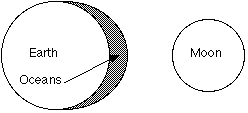
Simple is wrong
Thus clearly the simple explanation of "the moon pulls the oceans towards it by gravity" is wrong, for as the earth rotates through the bulge of water, there would only be one high tide and one low tide each day. Whatever is going on is more subtle than that. It wasn't until our old friend, Sir Isaac Newton, came along that we understood what was going on. Here is my "simplified" version of Newton's key insights. First, if you push on something, it starts moving in the direction of the push. Newton called this pushing a "force." This statement may seem obvious, but like a diamond in the rough, if you chip away at it, its many facets will be revealed. Let's take a look at some of them. Consider a bow and arrow: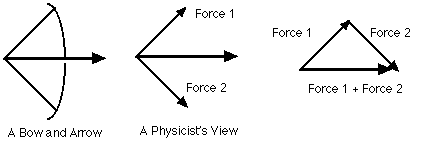
Vectors - but don't panic
The bowstring is pushing on the arrow. The top of the string is trying to pull the arrow up towards the top of the bow. If the bottom half of the string weren't there, and we released the arrow, the tail feathers would whack the top of the bow. However, the bottom half of the bowstring is there, and it is pulling the back of the arrow down towards the bottom of the bow just as hard as the top part of the string. The net result of these two forces is what every archer knows, that the forces pulling the arrow in the vertical direction cancel out, and the arrow winds up going straight ahead as the bowstring scrapes across your forearm causing intense pain. The arrow winds up going in the direction of the the sum of Force 1 and Force 2. We add forces by joining up the head of one with the tail of the other, and drawing a line from the original tail to the new head, as above. Okay, armed with this powerful insight, let's consider the following situation: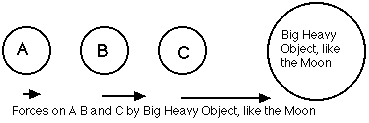
We have three masses, called A,B, and C a distance away from a big heavy object, like the moon, and B is exactly midway between A and C. Here we need another of Newton's key insights. He discovered that if two massive objects are near each other, the "force" (in this case a pull rather than a push) depends on how much they weigh (how much mass they have) and how far apart they are. The further apart they are, the weaker the pull. Thus the moon's pull on C is stronger than the moon's pull on B, because C is closer to the moon. Similarly, the moons pull on B is stronger than the moon's pull on A, because A is further away from the moon than B. This pull will cause A, B, and C to start moving towards the moon. Furthermore, because the pull on C is stronger than the pull on B, C will move towards the moon more quickly than B. That means that after a few seconds the distance between B and C will increase, because C is moving towards the moon more quickly than B is. Now exactly the same thing is true about A and B. B will move towards the moon more quickly than A, because it is closer, so the distance between B and A will increase. Now watch closely, this is where the rabbit is pulled out of the hat. Imagine that B is a giant piece of rock, surrounded by water that extends all the way out to the ends of A and C. Then, since the distance between B and C and B and A are both increasing, we would have a picture like this:
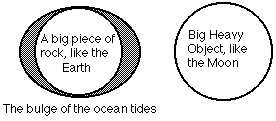
Careful!
Thus as the earth rotates around its axis in 24 hours, it will pass through 2 high tides and two low tides. Have I convinced you? Well, I'm sorry to say that this explanation is almost entirely bogus. Even though everything I have said is true, we have left out a crucial ingredient, namely the force of gravity that the Earth itself exerts on the oceans. The Earth is so much closer to the the ocean than the moon, and also more than 81 times heavier than the moon, that the force that the Earth exerts on the water is 9 million times stronger than the moon's force. Thus any lifting of the water that the moon does would be completely unobservable here on Earth. Would you notice the impact of a fly on a freight train? Neither would you notice the influence of the moon on the oceans based on the above argument. So what is really going on? It brings us back to the bow and arrow and the following picture: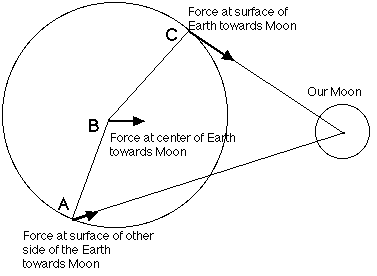
The real Answer
Things are not as neat as they were before, but the idea is the same. A is further from the moon than B, which is further from the moon than C. Thus the force at C is bigger than the force at B, which is bigger than the force at A. The new wrinkle is that at A and C, the Earth's gravity exerts a huge force towards the center of the earth, thus the only "leftover" force that could move the water is the force that is tangential (lies completely along the surface of) to the Earth. Thus what matters as far as the flow of water is concerned, is this tangential force, and also how things look from the perspective of B, someone sitting at the center of the Earth. Now look at the arrows in the above picture. You can see that relative to B, the water at C will flow down, since the arrow at C is longer than the arrow at B. Similarly, the water at A will flow up, since the arrow at A is shorter than the arrow at B. Here is a blown up picture so you can see what is going on: Thus
the water at C does indeed flow towards the moon, and bunches
up directly underneath it, while the water at A flows away
from the moon, and bunches up directly underneath it on the
opposite side of the Earth. I told you there was the beauty of
diamonds in that simple little statement of our friend Isaac,
didn't I? Now you know the real scoop, aren't you glad you
know more than just that "the North won?"
Thus
the water at C does indeed flow towards the moon, and bunches
up directly underneath it, while the water at A flows away
from the moon, and bunches up directly underneath it on the
opposite side of the Earth. I told you there was the beauty of
diamonds in that simple little statement of our friend Isaac,
didn't I? Now you know the real scoop, aren't you glad you
know more than just that "the North won?"
Quote of the day:
Don't accept your dog's admiration as conclusive evidence that you are wonderful.
Ann Landers
Don't accept your dog's admiration as conclusive evidence that you are wonderful.
Ann Landers
Sitemap
Go up to How do Things Work Go up to Home Page of Nadine Loves Henry
Go back to The Calendar Continue with Can I Count on You?